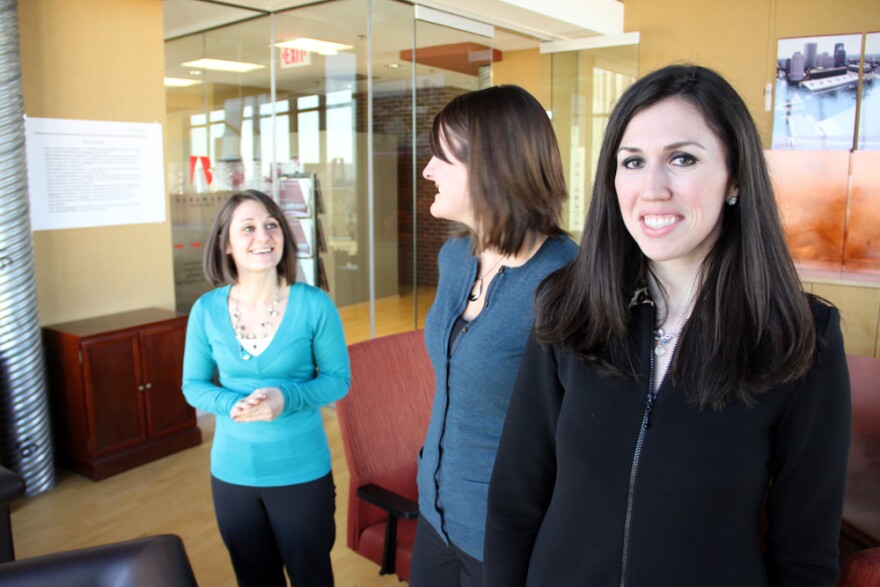http://stream.publicbroadcasting.net/production/mp3/wxxi/local-wxxi-960775.mp3
Attracting and keeping young people in upstate New York has long been a concern for policy makers, professional groups, and city boosters. But the hand-wringing about “brain drain” hasn’t stopped the region from aging.
Despite the demographics, Rochester seems to be sprouting more and more groups for young professionals of every stripe. The city’s local paper even has an entire section of its website devoted to them.
But are all these so-called “YPs” bucking upstate’s demographic trends, or simply living them out in real time?
Newest group in town
Three years ago, the founders of Rochester’s newly-formed Young PR Professionals group were getting ready to graduate from nearby Saint John Fisher College.
The Rochester-area natives had done the internships, joined the student chapter of the professional society and were lining up jobs for after graduation.
Now, longtime friends Kristy Guerra, Shannon Lappin and Paula Zimmer are adding to the 40 or so YP groups in the Rochester area alone.
The three PR “rock stars” - as one professor used to call them - say Rochester’s 20-minutes-to-anywhere size and the presence of several corporate giants are just a few of the reasons why the city is a great place to start a career.
“You can start being a big fish in a little pond, rather than being a little fish in a big pond,” says Guerra, who works for Bausch & Lomb. “You’re able to touch more things, you’re able to meet more people and do many different things because there’s not as many people that you’re competing with.”
Dismal demographics
In a region that’s trying to rebound from decades of steady economic decline, Guerra, Lappin and Zimmer stand out as positive outliers among mostly negative trend lines.
Although the region as a whole experienced a slight uptick in population since 2000, upstate continues to suffer from years of relative decline in population and economic strength.
Aside from the Capital Region, upstate cities were especially hard hit over the last decade.
Buffalo shed more than a tenth of its residents, Rochester shrunk by four percent and when Binghamton lost a total of four people, it was seen as a surprise victory.
Across the region, the outbound red lines in this interactive map far outnumber the inbound black ones.
“It sort of naturally leads to a conclusion that those people must be leaving the area,” says Federal Reserve Bank of New York economist Richard Deitz. But really, he says, it’s a lot more complicated.
“Brain drain” or just low “brain gain”?
In 2007, the Buffalo-based Deitz crunched the numbers on the 2000 Census to figure out why upstate’s population growth was so anemic.
By lopping off the 13 counties in the New York City area, Deitz could look at upstate New York as if it was a state of its own. He looked specifically at the constant churn of working-age people migrating in and out of the region.
Here’s what he found.
“When you look at the out-migration rate, upstate New York would rank right about in the middle compared to all other states,” says Deitz. “But when you look at the in-migration rates, upstate New York was second to last.”
Deitz concluded that upstate wasn’t suffering from a high amount of “brain drain.” It was actually suffering from a very low amount of “brain gain.”
“What’s really going on is that you’ve got people, especially the young and educated, who are footloose," says Deitz. “They’re looking across the country, and they can go anywhere they want.”
Where they’re not looking is upstate New York.
Positive signs?
“Upstate New York is definitely one of the slower growing regions of the country,” says Alan Berube, a senior fellow at Brookings.
Berube says young workers tend to go to larger places with growing job opportunities and warmer climates.
Places very much unlike, for example, Buffalo.
But Berube says the news isn’t all bad. In a big demographic report Brookings put out last year, Rochester and Syracuse were identified as what Brookings called “skilled anchors.”
“You’ve got a lot of highly skilled, highly educated workers in your region,” Berube says. “That doesn’t mean that that’s going to translate into rapid population growth anytime soon, but frankly that’s the most important thing for the prosperity of your region over the medium- and long-run.”
In the short-run, however, economists say upstate is having a hard time attracting highly-mobile, highly-skilled young workers, even if it’s OK at hanging on to some of its homegrown talent.
Which brings us back to the young PR professionals of Rochester: in about a month, one third of the trio is moving out of the region to take a job near Detroit.






